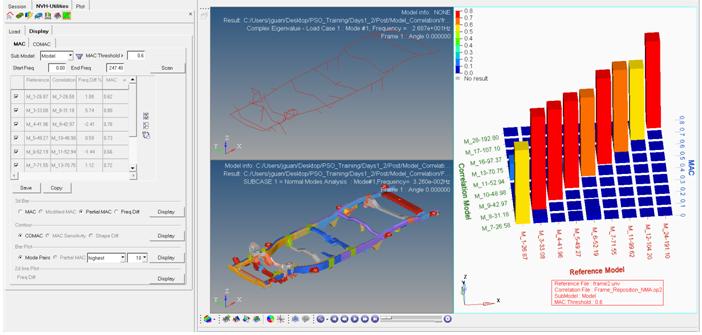Model Correlation
The Model Correlation utility determines the degree of similarity or correlation between two sets of results.

View new features for HyperWorks 2021.
Learn the basics and discover the workspace.
Discover HyperWorks functionality with interactive tutorials.
Learn how to create, open, import and save models.
Set up your sessions in HyperWorks and create report templates.
Solver interfaces supported in HyperWorks.
A solver interface is made up of a template and a FE-input reader.
Create, organize, and manage the CAE parts.
Create, edit, and cleanup geometry.
Learn about the different types of mesh you can create in HyperWorks.
Create and edit 0D/1D entities and edit 2D elements.
Rapidly change the shape of the FE mesh without severely sacrificing the mesh quality and create, edit, and apply shapes for subsequent design optimization studies.
Create connections between parts of your model.
HyperMesh composites modelings.
Tools used for crash and safety analysis.
The Design Space environment is dedicated to topology optimization model build and setup. It facilitates rapid model creation by generating the voxel design space for a number of different use cases.
Multi-disciplinary design exploration and optimization tools.
Many essential utility tools using HyperWorks-Tcl have been developed over the years to support Aerospace customers. A few tools have been collected and upgraded to be compatible with this release.
Import an aeroelastic finite element model with Nastran Bulk Data format.
Use the marine tool set to streamline the creation of properties and 1D stiffener mesh using the info read from Marine CAD tools.
Use Squeak and Rattle Director tool set to create evaluation lines, evaluate them and optimize the interfaces to eliminate squeak and rattle issues.
Panels contains pre-processing and post-processing tools.
HyperView is a complete environment to visualize, query, and process results data.
Open animation files, measure various distances and angles between entities, and use the Results Browser to view the model structure and find, display, and edit entities.
Create section cuts and explore the various result plotting tools.
Create and edit user-defined data type expressions, derived load cases, and systems. You can also plot a forming limit diagram, generate streamlines, track entities during animation, and create and import/export sets of entities.
Query entities, create or edit free body diagrams, construct multiple curves and plots from a single result file, and create and plot stress linearization.
Annotate animation files using notes or trace various entities during animation.
Define planes of symmetry/axisymmetry or explode a model.
Select and overlay images or videos in the modeling window for correlation and presentation purposes.
Select a graphics rendering mode and change the appearance of materials.
The Tools menu provides you access to various panels and dialogs.
Load preference file profiles to access the various Aerospace tools, NVH utilities, and Vehicle Safety Tools.
The Aerospace menu provides you with access to various aerospace tools.
The NVH menu provides you with access to various NVH utilities.
Allows you to plot modal/panel participation curves from an OptiStruct .h3d file or an MSC Nastran .f06/.pch file.
The Grid Participation utility allows you to plot panel grid participation results and then use advanced scaling contour capabilities to isolate key contributing areas.
Visualize the distribution of energy within a full vehicle NVH model, as a way to understand what components are dominating the vehicle response.
Identifies the complex contribution of the excited structure through attachment points to a response in the responding structure.
Design sensitivity represents a change in response with respect to a change in a design variable, which is typically used for optimization.
Generates and post-processes engine order related data from an OptiStruct or Nastran frequency response analysis that contains either RPM-based loading subcases or order-based loading subcases.
The Model Correlation utility determines the degree of similarity or correlation between two sets of results.
Modal Assurance Criterion (MAC) is a measure of the correlation between two vibration shapes.
PreTest allows prediction and optimization of the sensor locations (accelerometers) for measurements and directions along with test excitation point location, a very important step in the experimental modal analysis process directly affecting the accuracy of test results. Driving point residue (DPR) calculation gives information on optimum point for excitation location.
Frequency Response Assurance Criterion (FRAC) is a measure of the correlation between two frequency response functions (FRFs) representing the same input-output relationship.
Predicts powertrain rigid body mode frequencies and kinetic energy distribution, which play a critical role in optimizing the mount stiffness and layout configuration, by decoupling powertrain rigid body modes and reducing vibration transmission.
The Vehicle Safety Tools (VST) is a collection of over 200 macros, Templex functions, and external functions for use by a vehicle safety engineer.
From the Preferences menu, you can access the Options dialog.
Explore the various display and visualization tools.
HyperGraph is a data analysis and plotting tool with interfaces to many CAE file formats.
MotionView is a general pre-processor for Multibody Dynamics.
MediaView plays video files, displays static images, tracks objects, and measures distances.
TextView math scripts reference vector data from HyperGraph windows to automate data processing and data summary.
TableView creates an Excel-like spreadsheet in HyperWorks.
Create and export Document and Presentation reports with one click and also define your own report structure.
HyperView is a complete environment to visualize, query, and process results data.
Load preference file profiles to access the various Aerospace tools, NVH utilities, and Vehicle Safety Tools.
The NVH menu provides you with access to various NVH utilities.
The Model Correlation utility determines the degree of similarity or correlation between two sets of results.
The Model Correlation utility determines the degree of similarity or correlation between two sets of results.

(c) 2021. Altair Engineering Inc. All Rights Reserved.